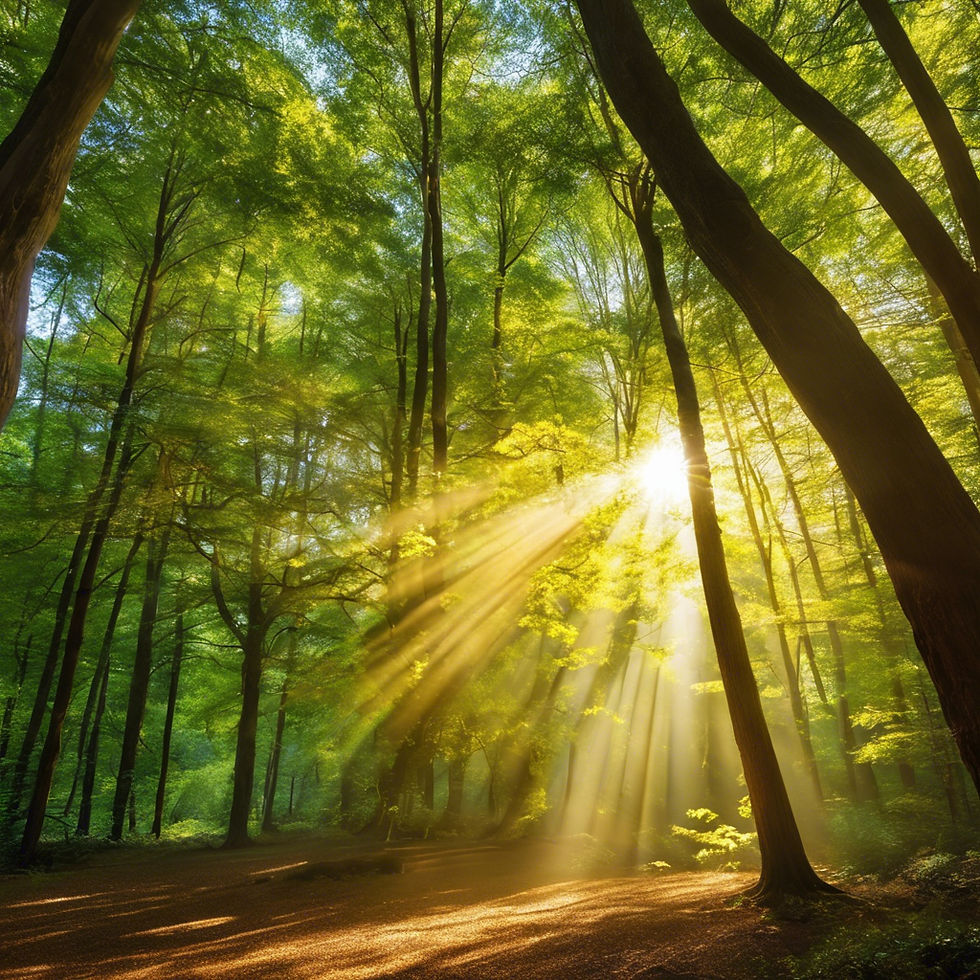Emerging from Isolation: From Pandemic Stress to Nature’s Embrace on the Path to Healing
- Klara Tselenchuk

- Sep 4, 2024
- 6 min read
What COVID-19 Taught Us About Mental Health and the Healing Power of Forest Therapy
The COVID-19 pandemic changed our world in so many ways, but it also brought important lessons. One of the most powerful realizations was the essential role of nature in healing and mental well-being. As a certified Forest Therapy guide, I have personally witnessed the transformative power of nature connection, especially in the wake of such challenging times. In this post, I want to share some insights about how forest therapy can help us recover from the stresses of the pandemic and emerge into a space of healing and peace.
The Mental Health Impact of COVID-19

During the pandemic, mental health concerns increased rapidly. Many of us felt overwhelmed by fear, uncertainty, and isolation. Anxiety and depression rates took off, with the World Health Organization reporting a 25% increase in anxiety and depression worldwide during the first year of the pandemic (World Health Organization. (2022, June 16). World Mental Health Report: Transforming mental health for all. The UMB Digital Archive).
For healthcare professionals, this burden was even greater. I have seen firsthand the emotional exhaustion and burnout that myself and many of my colleagues experienced. It became evident that self-care and emotional support were critical for survival - mentally, emotionally, and spiritually.
Beginnings | American Holistic Nurses Association
As Leslie Binford’s article in Beginnings, the Journal of American Holistic Nurses Association, (June 2024 | Volume 44 Number 3) highlighted, one of the major lessons from this time was the importance of holistic self-care, emphasizing mind, body, and spirit.
While self-care often brings up images of quiet reflection or pampering, the pandemic revealed a deeper need for reconnection - not just with ourselves but with the world around us. This is where nature, and more specifically forest therapy, enters the picture.
Nature as a Healing Force

One of the most compelling takeaways from the pandemic is the realization that nature can heal. As a society, many of us turned to nature for comfort when social gatherings and indoor activities were restricted.
Being outdoors, even in local parks or green spaces, helped people cope with stress and anxiety. Nature immersion has been shown to reduce cortisol levels, lower blood pressure, and improve mood.
I’ve personally experienced the healing benefits of nature long before I officially trained as a certified forest therapy guide. During the pandemic, like many others, I found comfort by simply spending time in nature - walking through the woods, breathing deeply, and unknowingly allowing its calming effects to wash over me. I didn’t fully realize it at the time, but I was engaging in what is now recognized as forest therapy. Nature has always been a source of peace and restoration, even when I wasn’t intentionally practicing mindfulness in the formal sense.
The Principles of Forest Therapy

Forest therapy, also known as Shinrin-yoku or forest bathing, is not about hiking or exercising. It’s about slowing down, being present, and opening up to the healing elements of the natural environment. As a certified guide, I lead participants through a series of mindful invitations, encouraging them to engage their senses and experience the world around them in a deeper way.
This practice is particularly valuable for mental health. By slowing down and observing nature, participants become more aware of their own thoughts and feelings. This awareness can help ease anxiety and foster a sense of calm. During my guided walks, I’ve seen people come to realizations about their emotions and find a sense of clarity and grounding that they didn’t expect.
Forest Therapy and Mental Health

The connection between mental health and nature is undeniable. Research shows that spending time in green spaces can reduce symptoms of anxiety and depression. This was especially important during the pandemic when so many people felt isolated and disconnected. Forest therapy offers a way to not only reconnect with nature but also to reconnect with ourselves.
As a forest therapy guide, I’ve seen the benefits of this practice in action. Participants on my walks often share how nature has helped them process difficult emotions or release stress they didn’t realize they were carrying. The simple act of walking slowly through the forest, breathing deeply, and taking in the sights and sounds of nature can have a profound effect on mental well-being.
The Science Behind Forest Therapy

Forest therapy isn’t just a feel-good activity - it’s backed by science. Forest environments have been shown to reduce levels of cortisol, the body's primary stress hormone, which can lead to chronic health problems if elevated for long periods. Trees release organic compounds called phytoncides, which have been found to boost immune function and reduce inflammation.
Moreover, the visual and auditory stimuli of nature - rustling leaves, birdsong, and flowing water - have been proven to trigger the parasympathetic nervous system, which is responsible for the body’s rest and digest response. This system helps to slow the heart rate, lower blood pressure, and promote feelings of calm.
This physiological response is particularly important for those recovering from high levels of stress, whether caused by the pressures of a healthcare setting or the emotional weight of a global pandemic. By providing a calm, restorative environment, forest therapy helps the body return to a state of balance and recovery.
The Spiritual Connection to Nature

In addition to the mental and physical benefits, forest therapy fosters a deep spiritual connection. For many people, spending time in nature rekindles a sense of awe, wonder, and interconnectedness. Nature reminds us of the larger cycles of life and death, growth and decay, which can provide comfort and perspective during times of personal crisis or grief.
Forest therapy invites participants to reflect on their place within these natural cycles. By engaging in slow, mindful interaction with the environment, people often feel a greater sense of belonging and purpose. This spiritual connection is a key aspect of holistic health, recognizing that our mental, emotional, and physical well-being is closely tied to our sense of meaning and connection to the world.
During the pandemic, when many people felt disconnected and isolated, this spiritual connection to nature provided a grounding force. It helped individuals find peace amidst uncertainty and gave them the tools to cope with loss, fear, and change.
The Role of Guided Forest Therapy

While anyone can benefit from spending time in nature, guided forest therapy sessions offer an added layer of support and structure. Forest therapy guides are trained to help participants engage more deeply with the natural environment, offering invitations and activities that encourage mindfulness, sensory awareness, and reflection.
Guided sessions often include group sharing, where participants can express their thoughts, emotions, and insights. This creates a supportive community where individuals can process their experiences together. For many people, this sense of shared experience adds to the healing power of forest therapy, offering a space for both solitude and connection.
During the pandemic, virtual forest therapy sessions also became popular, allowing participants to engage with nature from their homes or local parks. These sessions helped bridge the gap when travel and group gatherings were restricted, demonstrating the adaptability of forest therapy as a healing practice.
The Future of Forest Therapy and Mental Health

As we emerge from the pandemic, it’s clear that the lessons we’ve learned about mental health and the healing power of nature will continue to shape our lives. Forest therapy is becoming more widely recognized as a valuable tool for supporting mental health, with more programs being implemented in healthcare settings and communities around the world.
For those of us who have experienced the benefits of forest therapy firsthand, it’s exciting to see this practice gain recognition. I believe that as more people discover the power of nature connection, we will continue to see positive changes in both individual and collective mental health.
Conclusion: A Return to Nature

The COVID-19 pandemic taught us the importance of taking care of our mental health. For many, nature became a refuge - a place to process emotions, find peace, and reconnect with the world around us. Forest therapy offers a structured way to experience the healing power of nature, and as a certified guide, I am honored to share this practice with others.
Whether you’re looking to reduce stress, improve your mental health, or simply reconnect with yourself and the natural world, I encourage you to explore the benefits of forest therapy. The forest is always there, waiting to offer you peace, clarity, and healing.
If you’d like to experience the calming and restorative effects of nature, I invite you to join me for an in-person forest therapy walk. For those unable to attend in person, I also offer virtual walks—just send me an email at klara@natureliwhole.com for more information.
Let’s reconnect with the healing power of nature, together. 🌿




Comments